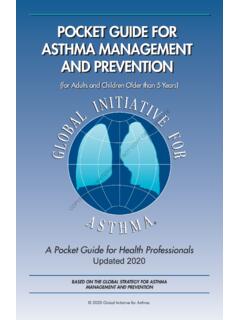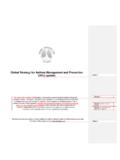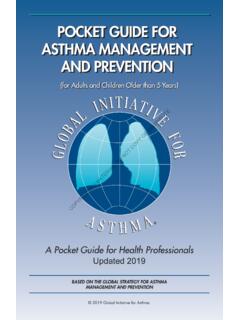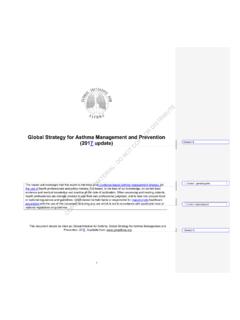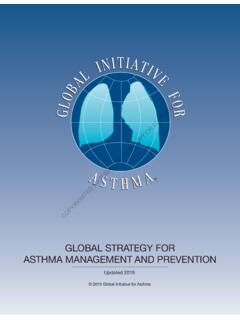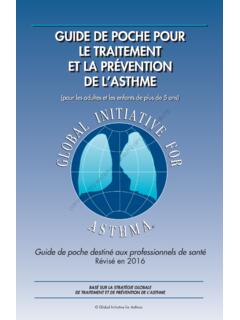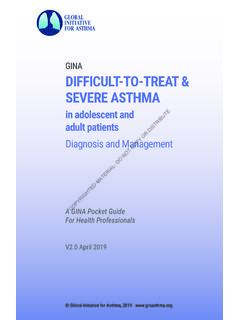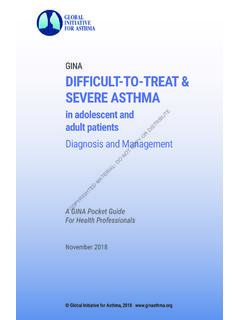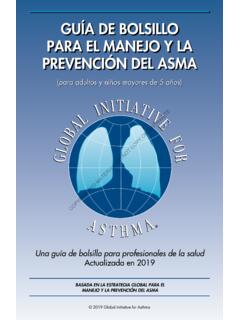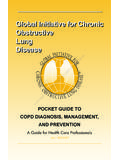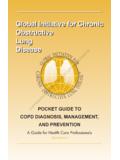Transcription of POCKET GUIDE FOR ASTHMA MANAGEMENT …
1 POCKET GUIDE FORASTHMA MANAGEMENT AND PREVENTIONA POCKET GUIDE for Physicians and Nurses Updated 2015 (for Adults and Children Older than 5 Years)BASED ON THE GLOBAL STRATEGY FOR ASTHMAMANAGEMENT AND PREVENTION Global Initiative for AsthmaCOPYRIGHTED MATERIAL - DO NOT ALTER OR REPRODUCECOPYRIGHTED MATERIAL - DO NOT ALTER OR REPRODUCE GLOBAL INITIATIVE FOR ASTHMA POCKET GUIDE FOR HEALTH PROFESSIONALS Updated 2015 GINA Board of Directors Chair: J Mark FitzGerald, MD GINA Science Committee Chair: Helen Reddel, MBBS PhD GINA Dissemination and Implementation Committee Chair: Louis-Philippe Boulet, MD GINA Assembly The GINA Assembly includes members from 45 countries, listed on the GINA website GINA Program Scientific Director: Suzanne Hurd, PhD Names of members of the GINA Committees are listed on page 28.
2 1 COPYRIGHTED MATERIAL - DO NOT ALTER OR REPRODUCETABLE OF CONTENTS Preface .. 3 What is known about ASTHMA ? .. 4 Making the diagnosis of ASTHMA .. 5 Criteria for making the diagnosis of ASTHMA .. 6 Diagnosing ASTHMA in special populations .. 7 Assessing a patient with ASTHMA .. 8 How to assess ASTHMA control .. 9 How to investigate uncontrolled ASTHMA .. 10 MANAGEMENT of ASTHMA .. 11 general principles .. 11 Treating to control symptoms and minimize risk .. 11 Control-based ASTHMA MANAGEMENT .. 12 Initial controller treatment .. 13 Stepwise approach for adjusting treatment.
3 16 Reviewing response and adjusting treatment .. 17 Inhaler skills and adherence .. 18 Treating modifiable risk factors .. 19 Non-pharmacological strategies and 19 Treatment in special populations or contexts .. 20 ASTHMA flare-ups (exacerbations) .. 21 Written ASTHMA action plans .. 22 Managing exacerbations in primary or acute care .. 23 Reviewing response .. 23 Follow-up after an exacerbation .. 25 Glossary of ASTHMA medication classes .. 26 Acknowledgements .. 28 GINA publications .. 28 TABLE OF FIGURES Box 1. Diagnostic flow-chart for ASTHMA in clinical 5 Box 2.
4 Features used in making the diagnosis of ASTHMA .. 6 Box 3. How to assess a patient with ASTHMA .. 8 Box 4. Assessment of symptom control and future risk .. 9 Box 5. How to investigate uncontrolled ASTHMA in primary care .. 10 Box 6. The control-based ASTHMA MANAGEMENT cycle .. 12 Box 7. Stepwise approach to ASTHMA treatment .. 14 Box 8. Low, medium and high daily doses of inhaled corticosteroids (mcg) .. 14 Box 9. Self- MANAGEMENT with a written action plan .. 22 Box 10. MANAGEMENT of ASTHMA exacerbations in primary care .. 24 Abbreviations used in this POCKET GUIDE are found on page 27.
5 2 COPYRIGHTED MATERIAL - DO NOT ALTER OR REPRODUCEPREFACE ASTHMA affects an estimated 300 million individuals worldwide. It is a serious global health problem affecting all age groups, with increasing prevalence in many developing countries, rising treatment costs, and a rising burden for patients and the community. ASTHMA still imposes an unacceptable burden on health care systems, and on society through loss of productivity in the workplace and, especially for pediatric ASTHMA , disruption to the family. Health care providers managing ASTHMA face different issues around the world, depending on the local context, the health system, and access to resources.
6 The Global Initiative for ASTHMA (GINA) was established to increase awareness about ASTHMA among health professionals, public health authorities and the community, and to improve prevention and MANAGEMENT through a coordinated worldwide effort. GINA prepares scientific reports on ASTHMA , encourages dissemination and implementation of the recommendations, and promotes international collaboration on ASTHMA research. The Global Strategy for ASTHMA MANAGEMENT and Prevention was extensively revised in 2014 to provide a comprehensive and integrated approach to ASTHMA MANAGEMENT that can be adapted for local conditions and for individual patients.
7 It focuses not only on the existing strong evidence base, but also on clarity of language and on providing tools for feasible implementation in clinical practice. The report was updated in 2015. This POCKET GUIDE is a brief summary of the GINA 2015 report for primary health care providers. It does NOT contain all of the information required for managing ASTHMA , for example, about safety of treatments, and should be used in conjunction with the full GINA 2015 report. GINA cannot be held liable or responsible for healthcare administered with the use of this document, including any use which is not in accordance with applicable local or national regulations or guidelines.
8 The GINA 2015 report and other GINA publications (listed on page 28) can be obtained from 3 COPYRIGHTED MATERIAL - DO NOT ALTER OR REPRODUCEWHAT IS KNOWN ABOUT ASTHMA ? ASTHMA is a common and potentially serious chronic disease that imposes a substantial burden on patients, their families and the community. It causes respiratory symptoms, limitation of activity, and flare-ups (attacks) that sometimes require urgent health care and may be fatal. can be effectively treated, and most patients can achieve good control of their ASTHMA . When ASTHMA is under good control, patients can: Avoid troublesome symptoms during day and night Need little or no reliever medication Have productive, physically active lives Have normal or near normal lung function Avoid serious ASTHMA flare-ups (exacerbations, or attacks) What is ASTHMA ?
9 ASTHMA causes symptoms such as wheezing, shortness of breath, chest tightness and cough that vary over time in their occurrence, frequency and intensity. These symptoms are associated with variable expiratory airflow, difficulty breathing air out of the lungs due to bronchoconstriction (airway narrowing), airway wall thickening, and increased mucus. Some variation in airflow can also occur in people without ASTHMA , but it is greater in ASTHMA . Factors that may trigger or worsen ASTHMA symptoms include viral infections, domestic or occupational allergens ( house dust mite, pollens, cockroach), tobacco smoke, exercise and stress.
10 These responses are more likely when ASTHMA is uncontrolled. Some drugs can induce or trigger ASTHMA , beta-blockers, and (in some patients), aspirin or other NSAIDs. ASTHMA flare-ups (also called exacerbations or attacks) may occur, even in people taking ASTHMA treatment. When ASTHMA is uncontrolled, or in some high-risk patients, these episodes are more frequent and more severe, and may be fatal. A stepwise approach to treatment, customized to the individual patient, takes into account the effectiveness of available medications, their safety, and their cost to the payer or patient.
